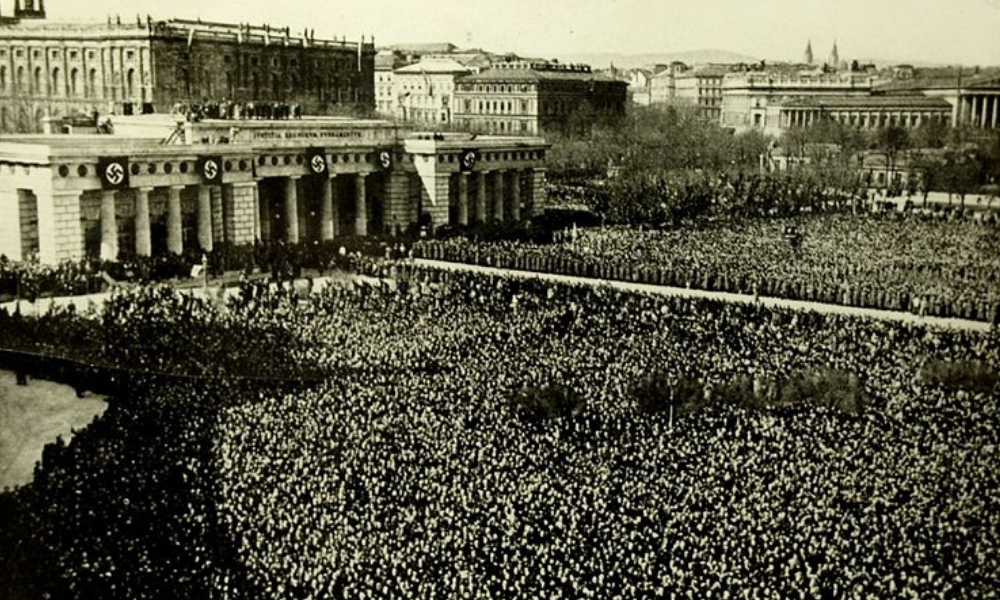On the morning of March 15, 1938, Adolf Hitler left his room at Vienna’s Imperial Hotel for the short ride down the Ringstrasse to the Neue Burg, the final wing added to the sprawling Hofburg imperial palace completed in 1919. The Neue Burg is situated on Heldenplatz (Heroe’s Square) where some 250,000 Austrians had gathered to hear him speak. Standing on the large balcony overlooking the square, Hitler proclaimed the Anschluss, the annexation of Austria into the greater German Reich: “The oldest Ostmark”—the Nazi name for Austria, meaning its eastern borderland—“of the German people shall be the youngest bulwark of the German nation and thus the German empire.”
Since 1945, the balcony has been closed to the general public. Now, with the opening of the House of Austrian History, Vienna’s contemporary history museum, in 2018, the question of the balcony’s fate has resurfaced. The new museum marks another step toward Austria coming to terms with its Nazi past, and museum director Monika Sommer believes that the balcony—an obvious symbol of Nazi rule in Vienna—should be accessible again.
The current “restraining order” that prevents people from setting foot on the balcony was not an “appropriate” way to approach or deal with its history, she said in a recent interview with the DPA, the German wire service. Sommer said she wanted to open the balcony—formally named the Alma Rosé-Plateau, in honor of the violinist and niece of the composer Gustav Mahler, yet more commonly called the “Hitler-Balkon,” the Hitler balcony—to guided tours, thus controlling access to the space. The move would represent a different approach to the way Austria deals with these spaces tainted by National Socialism, she said.
Her call is supported by Sabine Schatz, the Social Democratic Party’s spokesperson for matters pertaining to Austria’s “culture of remembrance.” She tells me she is “generally in favor of opening the balcony,” provided it can become a place for “political and historical education.” Schatz argues it is vital Austria “confronts” its history, rather than “neutralizing” it. Willi Mernyi, chair of Austria’s Mauthausen Committee (MKÖ)—an NGO whose cultural and educational work seeks to preserve Holocaust memory in Austria—tells me he backs Sommer’s proposal, and in particular, the idea that the balcony only be opened to tours such that guides could provide “context” and “clarification” for visitors. The Hitler-Balkon “must not become a pilgrimage site for neo-Nazis,” Meryni says.
Oliver Rathkolb, professor of contemporary history at the University of Vienna, was part of an international committee of historians and other experts who, back in 2015, recommended the Neue Burg be the home for the future House of Austrian History, and that the Hitler-Balkon be made accessible. Sommer’s call to open the balcony is not a new one. She herself made the suggestion back in 2018—80 years after both the Anschluss and Kristallnacht—and again in 2019. For Rathkolb, opening the museum and the balcony went hand-in-hand—“for me, as a historian, there is no other option”—but in 2015, 2018 and 2019, discussions around the balcony went nowhere, he tells me, due to budgetary and bureaucratic wrangling.
Indeed, Sommer’s latest call to open the balcony will likely run into opposition from the Burghauptmannschaft Österreich (BHÖ)—a subdivision of the Ministry for Digitalisation and the Economy, run by Margarete Schramböck of the conservative People’s Party (ÖVP)—the office which oversees former imperial palaces now owned by the Austrian state. A spokesperson for the BHÖ tells me that the “historic nature of the structure and the building conditions on-site” mean that “unfortunately” it would “not be possible to open [the balcony] to the general public.”
For Rathkolb, the Hitler-Balkon is fundamentally different from another contentious historical site whose fate has been the subject of intense debate in Austria in recent years: the house in Braunau-am-Inn where Hitler was born. In June 2020, the Austrian government presented plans to turn the building into a police station, acting on a recommendation made by an expert committee on which Rathkolb served in 2016. While the so-called “Hitler-Haus” is an accident of history, Heldenplatz and the balcony are sites of real historical import, Rathkolb says. He describes Heldenplatz to me as a “battleground of Austrian history,” the focal point of Austrian historical memory.
Over the decades, left, right and center have converged on Heldenplatz as a site of protest, celebration and commemoration. In 1929, then-Vienna mayor Karl Seitz addressed the largest gathering of international socialist youth organizations from the balcony; in 1934, the square became a site of mourning for the assassinated Austrofascist dictator Engelbert Dollfuss. The largest demonstration in Austrian history took place on Heldenplatz when, on January 23, 1993, 300,000 people created a “sea of lights,” protesting far-right xenophobia and intolerance. Opening the Hitler balcony, Rathkolb argues, could place it within the context of Heldenplatz’s far larger history.
By keeping the balcony closed, Rathkolb tells me, the Austrian state is guilty of “neglecting the history” of both it and the square, currently an underutilized space, part of which is a parking lot for employees and guests of the Organization for Security and Co-operation in Europe (OSCE), headquartered in the Neue Burg. Opening the balcony, he says, would be a way both of contextualizing the balcony’s Hitler connection within the square’s far larger history and showing “the international public that Austrians have learned the lessons of the Nazi past, of the Shoah, and of collaboration.”
Since the Holocaust, only one other person has held a speech from the Hitler-Balkon. On June 17, 1992, Elie Wiesel addressed attendees of an event called the Concert for Austria, organized to protest the downplaying of the National Socialist period by then-far-right leader Jörg Haider. Confronting Austria’s relationship with its Nazi past, the Nobel Prize-winner said: “The balcony is nothing. It is a symbol—nothing more. The catharsis, the change cannot come from the balcony. It must come from below.”
Top Photo: Hitler speaks at the Hero’s Square (Heldenplatz) in Vienna, Austria, March 1938. From the private collection of H. Blair Howell

